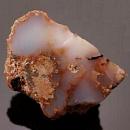|
|
||||||||||||||||
|
||||||||||||||||
|
||||||
|
|
|
|
Roeblingite
|
|
| | |
| Discovered in 1897; IMA status: Valid (pre-IMA; Grandfathered) | ||
|
| ||
|
Chemistry |
|
|
| |
|
Pb2Ca6Mn2+Si6O18(SO4)2(OH)2 • 4(H2O) | |
|
|
Hydrated Lead Calcium Manganese Silicate Sulfate Hydroxide |
|
Molecular Weight: |
1,409.57 gm |
|
Composition: |
Calcium |
17.06 % |
Ca |
23.87 % |
CaO |
|
|
Silicon |
11.95 % |
Si |
25.58 % |
SiO2 |
|
|
Hydrogen |
0.72 % |
H |
6.39 % |
H2O |
|
|
Lead |
29.40 % |
Pb |
31.67 % |
PbO |
|
|
Sulfur |
4.55 % |
S |
11.36 % |
SO3 |
|
|
Oxygen |
36.32 % |
O |
|
|
|
|
|
100.00 % |
|
98.86 % |
= TOTAL OXIDE |
|
|
|
||||
|
Classification |
|
|
| |
|
Silicates (Germanates) | |
|
8/E.02-30 | |
|
|
9 : SILICATES (Germanates)
|
|
Related to: |
n/a |
|
Varieties: |
None |
|
Synonyms: |
None |
|
|
|
|
Crystal Data |
|
|
|
|
|
As dense, compact, very fine grained masses of tiny lathlike crystals, which may be in parallel growth; as platy aggregates. |
|
|
None |
|
|
|
|
|
Physical Properties |
|
|
|
|
|
Perfect on {001} |
|
|
Fibrous |
|
|
Brittle |
|
|
3.0 |
|
|
3.443 (g/cm3) |
|
|
Fluoresces dull red to dull orange-red under SW UV. |
|
|
Not Radioactive |
|
|
Health Warning: |
CAUTION: Contains Lead - always wash hands after handling. Avoid inhaling dust when handling or breaking. Do not lick or ingest. |
|
|
|
|
Optical Properties |
|
|
|
|
|
White to pale pink; colorless in thin section |
|
|
Transparent, Opaque |
|
|
Dull to somewhat resinous. General appearance is porcelanous. |
|
|
1.640 - 1.660 Biaxial ( + ) |
|
|
0.020 |
|
|
Relatively weak; r < v |
|
|
None |
|
|
|
|
|
Occurances |
|
|
|
|
|
Geological Setting: |
As nodular masses in calcium silicate lenses containing abundant garnet (Franklin, New Jersey, USA); as fracture fillings in a metamorphosed Fe{Mn orebody (Långban, Sweden). |
|
Common Associations: |
Garnet, Titanite, Zircon, Phlogopite, Axinite, Willemite, Datolite, Barite, Calcite, Arsenopyrite, Sphalerite, Rhodonite, Rhodochrosite. |
| Associated Minerals at type locality: |
Willemite, Ganophyllite, Epidote-(Pb), Clinohedrite, Baryte, Andradite |
|
Common Impurities: |
Sr, Na, K, C |
|
Type Locality: |
Parker shaft, Franklin Mine, Franklin, Franklin Mining District, Sussex County, New Jersey, USA |
|
Year Discovered: |
1897 |
|
View mineral photos: | |
|
|
|
|
More Information |
|
|
|
|
|
| |
|
|
|
|
Roeblingite was
among the first of the lead silicate minerals found
at Franklin, many of which are known only from Franklin and
from Långban, Värmland, Sweden, the only other location
where Roeblingite can be found. Roeblingite
is valued for its rarity, its discovery at the Franklin
Mine and its fluorescent properties. It fluoresces dull
red to orange-red under shortwave UV light. |
|
|
We
have not photographed our Roeblingite gems yet. Please
check back soon. |
